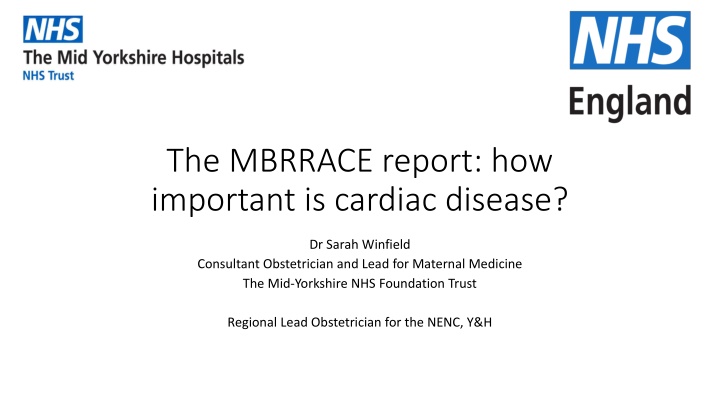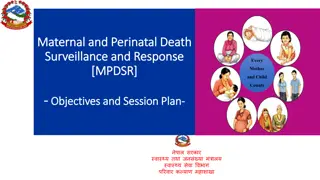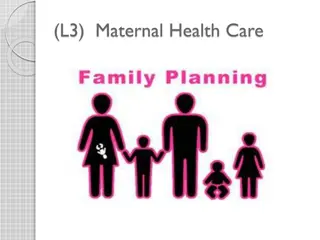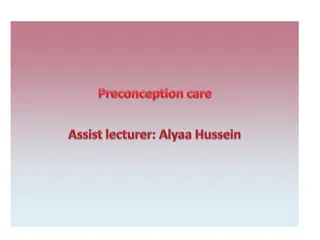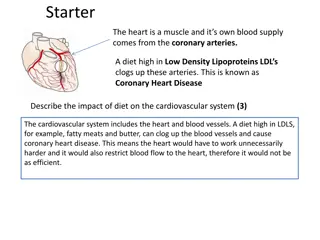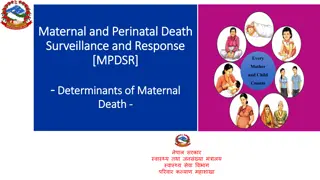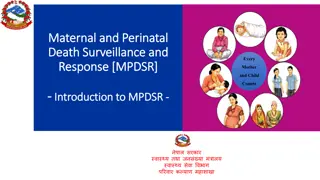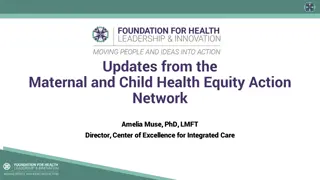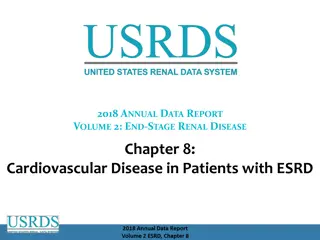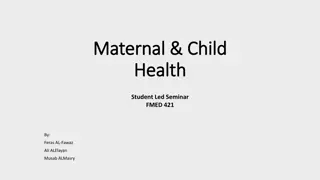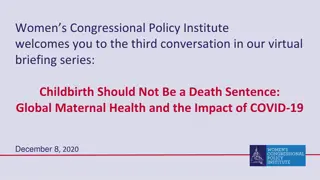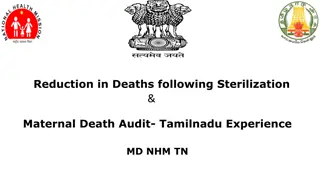The Importance of Addressing Cardiovascular Disease in Maternal Health
Cardiovascular disease remains a significant contributor to maternal mortality in the UK, with maternal deaths from cardiac issues outnumbering those from other direct causes, except thrombosis. The prevalence of cardiovascular risk factors in pregnant women, combined with a lack of consideration for cardiac health in reproductive-aged women, underscores the urgent need for increased awareness and proactive management of cardiac conditions in maternal care.
Download Presentation

Please find below an Image/Link to download the presentation.
The content on the website is provided AS IS for your information and personal use only. It may not be sold, licensed, or shared on other websites without obtaining consent from the author.If you encounter any issues during the download, it is possible that the publisher has removed the file from their server.
You are allowed to download the files provided on this website for personal or commercial use, subject to the condition that they are used lawfully. All files are the property of their respective owners.
The content on the website is provided AS IS for your information and personal use only. It may not be sold, licensed, or shared on other websites without obtaining consent from the author.
E N D
Presentation Transcript
The MBRRACE report: how important is cardiac disease? Dr Sarah Winfield Consultant Obstetrician and Lead for Maternal Medicine The Mid-Yorkshire NHS Foundation Trust Regional Lead Obstetrician for the NENC, Y&H
An older obese diabetic woman with a family history of cardiac disease underwent IVF with multiple embryo replacement. Her pregnancy was complicated by pre-eclampsia and she had an extremely preterm delivery. In the postnatal period she developed arm and hand pain which did not resolve. She was found collapsed the following day and could not be resuscitated. There was evidence of coronary atheroma and acute infarction at postmortem.
Why are you here today? Cardiovascular disease has been the single leading cause of maternal death in the UK since the 2000-02 triennium Changing maternity population, with increasing numbers of women deferring pregnancy until they are older, so are at greater risk of cardiovascular disease Higher numbers of pregnant women with known cardiovascular risk factors (hypertension, obesity, diabetes) Successful prevention of maternal deaths from obstetric causes Maternal mortality rate from cardiovascular disease has now been static with little evidence of change since the beginning of this century. More women die from cardiovascular disease in pregnancy than from all the direct causes added together, with the exception of thrombosis and thromboembolism. There is clear evidence that the possibility of cardiovascular disease in a woman of reproductive age is still frequently not considered at presentation.
Acquired Cardiac Disease is a big problem 11% SADS MNH 22% Ischaemia 26% Myocardial disease 24% Aortic dissection 7% Valve disease 5% Pulmonary Artery HTN 4% Systemic Hypertension 7% Congenital Heart Disease
MBRRACE 2016 Cardiac Recommendations Guidance is needed on maternal medical assessment and screening prior to assisted reproduction, particularly for older women who are at higher risk of co-morbidities such as cardiac disease and cancer. Genetic counselling should state for women known to be carriers of any inherited condition, whether the associated genetic mutation is known or unknown, and whether they need a cardiovascular risk assessment in pregnancy. Anyone with a family history or genetic confirmation of aortopathy or channelopathy should be referred for cardiac assessment before pregnancy. Review of the RCOG Responsibility of Consultant on Call guidance is needed to ensure that deviation from the usual clinical pathway, with unexpected or unexplained symptoms, triggers consultant review. Maternal medicine networks which are being developed in England and similar structures in the devolved nations should define pathways of referral for women with multiple and complex problems. A persistent sinus tachycardia is a red flag and should always be investigated, particularly when there is associated breathlessness.
Previous Recommendations (some not implemented) Previous Recommendations (some not implemented) Clear guidance on contraceptive choices for women with cardiac disease Repeated presentation with pain and/or pain requiring opiates - red flag and warrants a thorough assessment of the woman to establish the cause. Pain severe enough to prevent a woman caring for her baby represents a similar red flag . A raised respiratory rate, chest pain, persistent tachycardia and orthopnoea are important signs and symptoms of cardiac disease which should always be fully investigated. The emphasis should be on making a diagnosis, not simply excluding a diagnosis. Possibility of a cardiac diagnosis when repeated attempts are made to access medical care, particularly when extreme anxiety and breathlessness are prominent symptoms. Syncope during exercise can suggest a cardiac origin, and should prompt cardiac evaluation. ECG and measurement of troponin levels are recommended when a pregnant woman has chest pain. Echocardiography is recommended in any pregnant patient with unexplained or new cardiovascular signs or symptoms, following appropriate initial diagnostic investigation.
Previous Recommendations (some not implemented) Previous Recommendations (some not implemented) Following resuscitation from an arrest with a likely cardiac cause, coronary angiography percutaneous coronary intervention is the appropriate initial diagnostic investigation. Electrical cardioversion is safe in all phases of pregnancy. Immediate electrical cardioversion is recommended for any tachycardia with haemodynamic instability and for pre-excited atrial fibrillation. When aortic dissection occurs in a young woman, the underlying diagnosis should be assumed to be an inherited aortopathy until proven otherwise. If there are concerns about patient compliance or access to diagnostic testing then there should be a low threshold for admission to hospital Implementation of changes to the anticoagulation regimen during pregnancy or postpartum as per ESC guidelines.
A primiparous woman became hypertensive after a caesarean birth at term for fetal distress. Over the following few days she had severe abdominal pain, a numb foot, diarrhoea and an ongoing need for analgesia including opiates. Staff were aware of her pain but interpreted it as normal post caesarean discomfort and she was not seen by a consultant. She was discharged but was in too much pain to interact with her baby and family. Two days later, she was seen by the community midwife, her pain was worse, her abdomen was bruised and her foot numb. After a phone call to the GP, more analgesia was prescribed but the GP did not review her. Later that day she had copious bloody diarrhoea and collapsed. She was taken to labour ward, where she was in extremis with rectal bleeding, a grossly distended and bruised abdomen, hypotension and acidosis. She was taken straight to theatre for emergency surgery but died from complications of her extensive aortic dissection.
